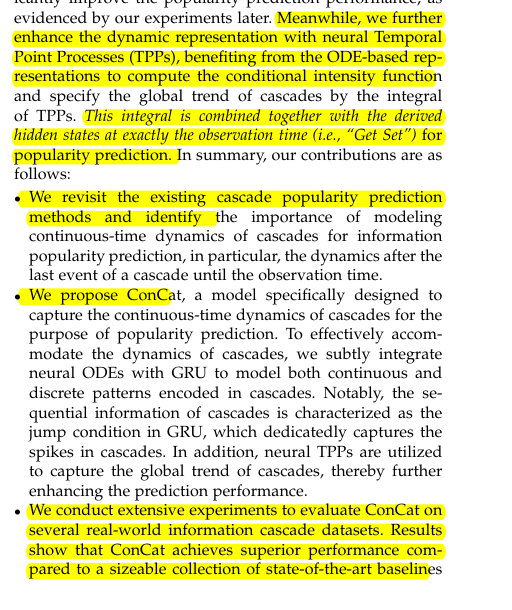On Your Mark, Get Set, Predict! Modeling Continuous-Time Dynamics of Cascades for Information Popularity Prediction
ConCat, proposed in this paper uses math from physics to track how information spreads online, just like tracking particles in motion.
ConCat, proposed in this paper uses math from physics to track how information spreads online, just like tracking particles in motion.
Think physics equations, but for predicting which tweets go viral
Original Problem 🔍:
Information cascade popularity prediction is challenging due to complex temporal dynamics and irregular events. Existing methods struggle to capture continuous-time patterns and global trends effectively.
Solution in this Paper 🛠️:
• ConCat: A model for continuous-time dynamics of cascades
• Uses neural ODEs to model irregular events in continuous time
• Incorporates GRU for discrete event jumps
• Employs neural TPPs to capture global cascade trends
• Aligns hidden states at unified observation time for prediction
• Combines ODE hidden states and TPP intensity integral for final prediction
Key Insights from this Paper 💡:
• Continuous-time modeling crucial for irregular cascade events
• Propagating last event state to unified observation time improves accuracy
• Neural TPPs effectively capture global cascade trends
• Combining local structural patterns with global trends enhances prediction
Results 📊:
• ConCat outperforms state-of-the-art baselines across three datasets:
• MSLE improvement: 6.1%-21.1%
• MAPE improvement: 2.2%-7.8%
• R² improvement: 2.5%-33.2%
• Ablation studies confirm effectiveness of key components:
• Neural ODEs, observation time alignment, neural TPPs
ConCat consists of four main components: 👨🔧
Structural learning of the cascade graph and global graph using existing graph embedding methods
Temporal dynamics modeling using neural ODEs and gated recurrent units (GRUs) to handle both continuous patterns between events and discrete jumps at new events
Global trend modeling using neural TPPs to capture the overall cascade characteristics
A prediction module that combines the aligned hidden states from the ODE model and the integral of the TPP intensity function
ConCat improves upon existing methods by:
Modeling the continuous-time dynamics between irregular cascade events using neural ODEs instead of discrete-time RNNs
Propagating the last event state to a unified observation time for different cascades
Capturing global cascade trends using neural TPPs in addition to local structural and temporal patterns




